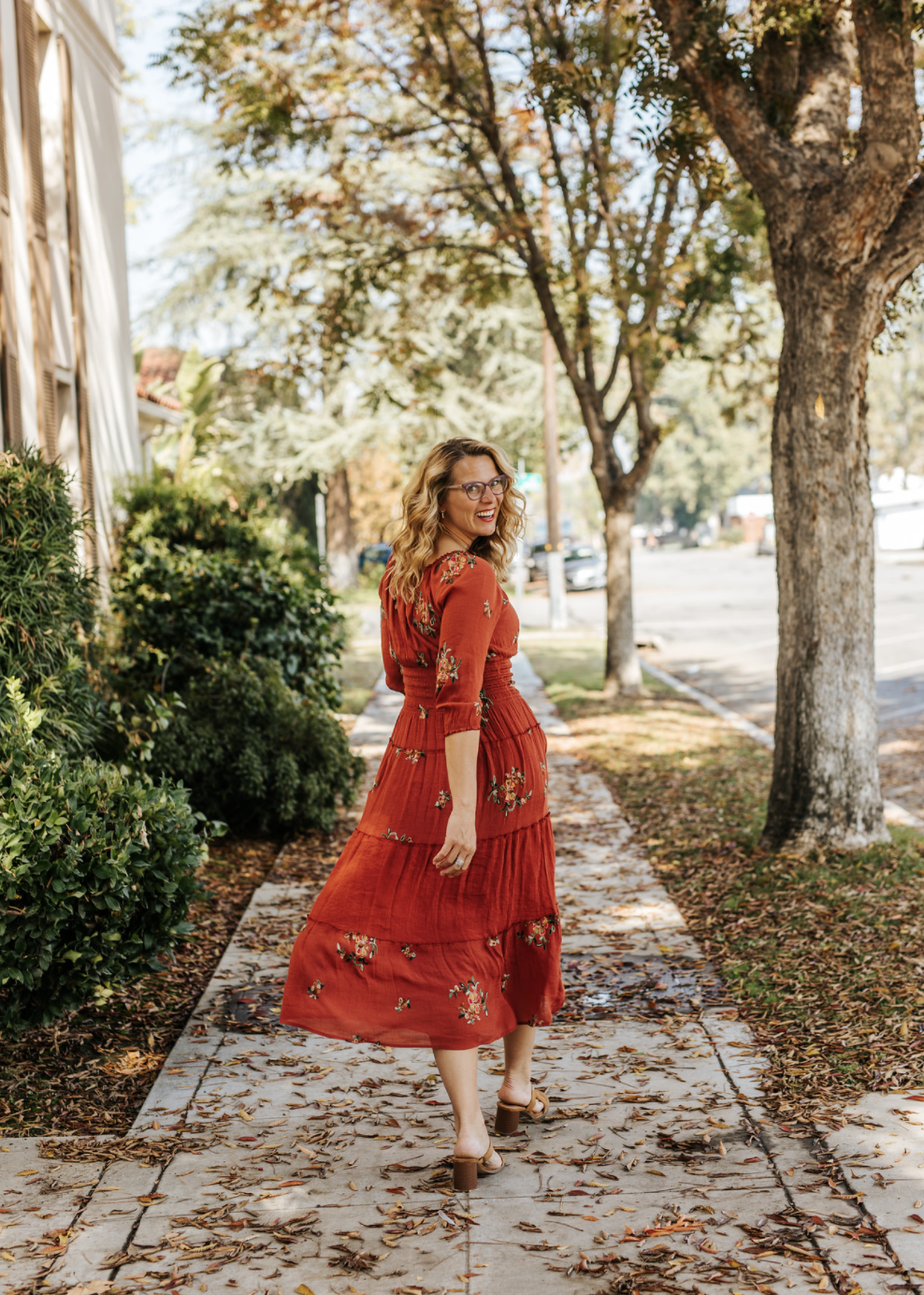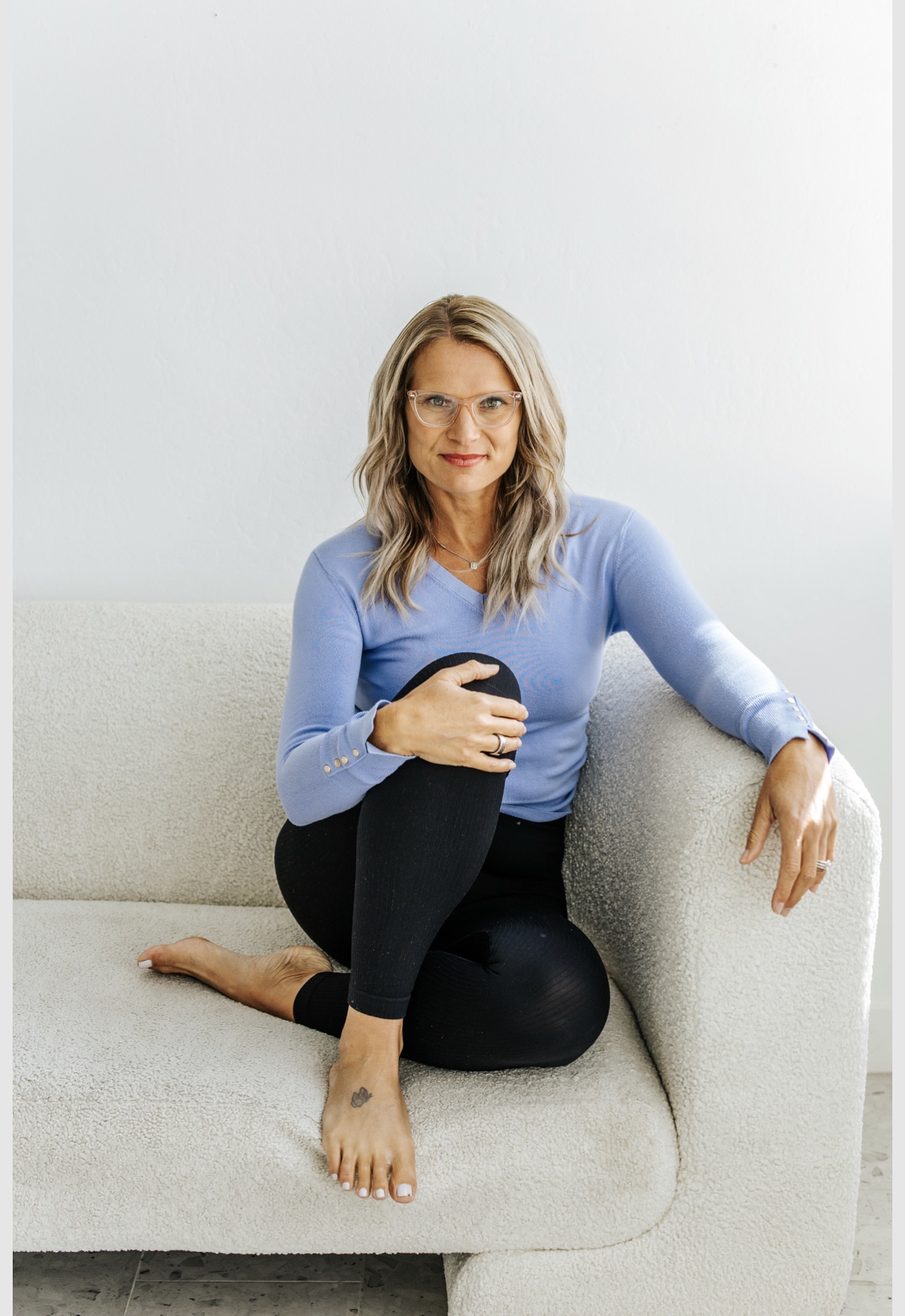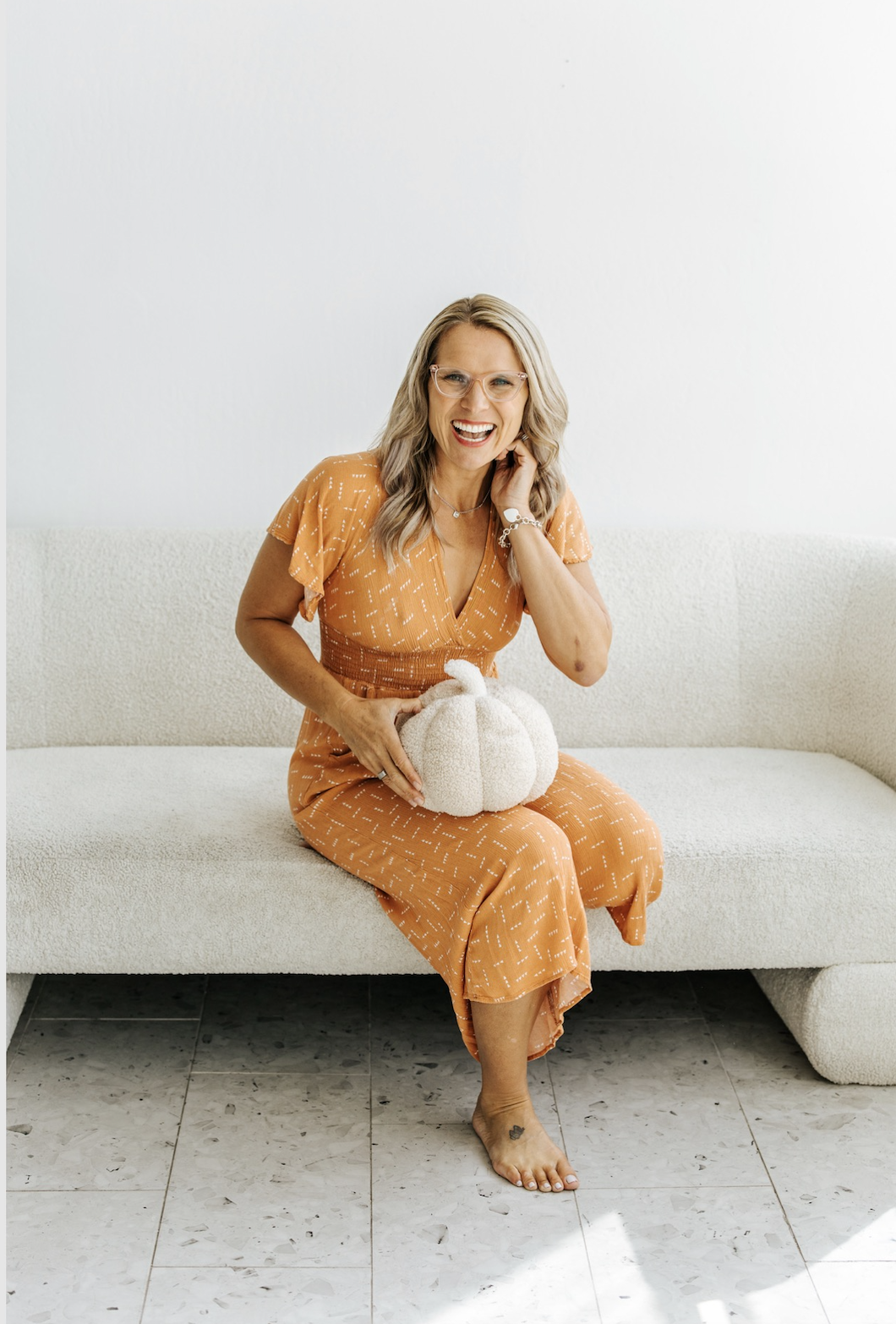Modern Diseases, Modern Failures: The Rheumatoid Arthritis Edition
Remember when you were a kid and you would wake up in the morning and nearly jump out of bed?
You’d throw off the covers, slide your feet down onto the rug, rub your sleepy eyes, and amble off to the breakfast table.

photo via Unsplash by Annie Spratt
As the years went on, though, mornings got harder and harder.
You would wake up with the alarm, sleepily hit the snooze button, and take your time stretching your arms and legs, gingerly testing your feet on the floor.
It was going to hurt. Every morning, more and more pain.
Why do your feet hurt every single morning? Why are your knuckles too swollen to get your wedding ring on and off? Why is your hip so tight you can barely walk?

photo via Unsplash
You’re still 30, or 40, or 50! You’re too young to be limping about like an octogenarian.
You’ve tried cortisone cream. You’ve gotten shots and taken pills. You may have even tried chemotherapy, enduring weekend after weekend of nausea in the hopes that your joints would feel better come Monday.
Have you gotten a diagnoses of rheumatoid arthritis? Or arthritis in general?
Rheumatoid Arthritis (RA) is an inflammatory condition that attacks the joints of the body, mainly the hands and feet. Sufferers can feel pain in their hips and back and sometimes in their eyes, skin, or lungs. As an autoimmune condition, RA attacks your body- or more appropriately, your body attacks itself.
With 200,000 new cases a year, most of these being women, the prevalence of RA has been steadily increasing over the past decade. Forty-one out of every 100,000 people have RA, and the disease starts to hit between the ages of 30-60.
The pain of having swollen hands and feet is bad enough on its own, but RA sufferers also bear the burden of being at risk of heart attack or stroke- a 60% increase of possibility one year after diagnosis. Not surprisingly, sufferers are 2x more likely to suffer from depression than their arthritis-free counterparts.
This is a big deal.
Heart attacks and depression? That is no way to live your life. You should be allowed to not worry about those things in your 30s, 40s, 50s, and beyond.
Let’s think about what is going on in life for women during their 30s, a common time for RA onset.
She is in the middle of raising young children, with the physical, emotional, and financial burden that is part of this package.
Or she is child-free by choice or circumstance and possibly mourning that part of her life.
She is in the throes of marriage and all that entails. The sacrifice and commitment and highs and lows that comes with being yoked to another sinner.
Or she is marriage-free by choice or circumstance and possibly mourning that part of her life.
As an official adult, her job may be more stressful. She may be caring for older parents, or siblings, or others that depend on her.
She may think that she has to do it all, or it will all fall apart.
And she realizes that she is not getting any younger. The whimsy and excitement of youth is over. While in her 20s, she may have been able to keep late nights with the help of cocktails and keep early mornings with the help of coffee, this is no longer a lifestyle choice that she can sustain and still function well.
And her body may start to shut down.
Has this happened to you?
It’s happened to me.
My hormones tanked, my energy became nonexistent, my virus got ahold of me and stuck around for awhile, my sleep left me, and my Hashimoto’s and psoriasis flared up.
Do you want to know what I did for awhile? I thought that changing my diet to more of a plant-based approach would help me, so I cut out all animal products.
The kids call this “plant-based”, a slightly more politically correct term than “vegan”.
I went plant-based for about 20 days. I ate nuts and fruit for breakfast, big salads with tons of veggies and lentils for lunch, and salads and veggies and beans for dinner.
A surprising thing happened. I started waking up with pain. Specifically, joint pain. My fingers and thumb joints were achy and swollen. My feet hurt. I felt heavy, despite the fact that I was eating no meat, butter, or dairy, a decided departure from my normal diet.
It took me a few days to realize that my diet was causing my pain. This sent me for a bit of a mind trip because I figured I was doing the best thing for my body with my little dietary experiment.
My body did not agree with me. I went off the lentils and beans and excessive vegetables and within a day, my hands and feet were back to their normal, flexible, pain-free selves.
Granted, this is only a single case. And clearly I did not have RA, simply a transient bit of swelling and inflammation.
But the observation was powerful enough to send me into the research.
Like this one, where it’s shown that the lectins in pulses and vegetables are correlated with the pain and swelling of RA.
Or this one, which links a standard American diet and the ensuing insulin resistance with RA.
Or this one, which suggests that plant lectins can start the inflammatory process associated with RA. This study also suggests that high levels of leptin in the blood are associated with RA. Leptin is our satiety hormone. It is what makes us full. If leptin levels are constantly high in the bloodstream, this means that we have leptin resistance. Similar to insulin resistance, the body is unable to use leptin properly, meaning that hunger/fullness cues will be off and you’ll have a hard time knowing when to know you are actually full. Therefore, according to the study, there is a correlation between excess weight and RA.
The study goes on to show the following factors as possible causes of RA:
- sugary drinks, especially those with high-fructose corn syrup
- fruit juices
- plant seeds containing lectins
- obesity
and this laundry list of infections:
- viruses (EBNA-1) (look! it’s our old friend Epstein Barr!)
- bacteria (Micrococcus luteus, Mycobacterium gastri, Nocardia brasiliensis)
- fungi (Aspergillus fumigatus, Candida albicans, Cryptococcus neoformans)
- plants (Oryza sativa, Solanum lycopersicum, Glycine max) in population colonized with Porphyromonas gingivalis
In my opinion, RA is caused by a cascade of events.
A crappy diet, followed by low thyroid function, followed by infection like EBV or candida, followed by RA.
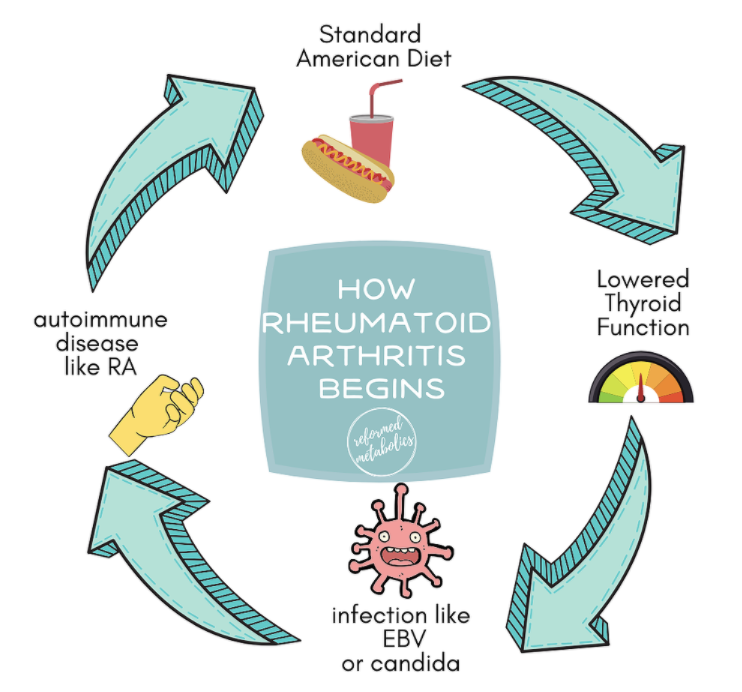
This is just my theory, but it seems a reasonable one.
Knowing that most of us are walking around with subclinical hypothyroidism, our body temperatures are just too low to fight off chronic diseases like Epstein Barr or mold or candida. This lowered body temperature is brought on by not eating enough nourishing food. That can take a few forms- eating a crappy, standard western diet, overexercising and over-dieting, or choosing a diet like veganism that is too low in calories and essential nutrients to keep your thyroid humming along nicely.
Once that infection sets in, you’ve got a body environment that is ripe for turning on your autoimmune disease genes.
For some of us, it’s too late. The infection and subsequent autoimmune disease is there.
But for the love, moms- please let’s reverse this cycle with our children!
Make sure your daughters get:
- animal products
- plenty of meat
- tons of protein
- butter
- low glycemic fruit
- low lectin vegetables
And plenty of them.
Your responsibility is to reduce the amount of packaged, processed, fried, cafeteria food. You are the mama and you can control this part of their lives. Teach them well so they can be well. Contact me if you need help. I spend a good part of my week at work educating young women in how to best care for themselves nutritionally.
I am not going to bore you with the suggestions on rest, sleep, and exercise. You already know what to do there. Please refer to the guides on Hashimoto’s, Lupus, and the Gut for more information on these necessary holistic interventions.
Let’s get into the nutrition recommendations.
Meat will not cause you to flare, especially in the absence of lectins. Reducing systemic inflammation through an ancestral diet is a great way to start healing your RA.
As always, I recommend the following:
I use this with nearly every client, and nearly every client starts feeling better within the first few weeks.
Join our 28 Day Reset and get a free clinic hour with me. This basically means that I am paying you $3.00 to do the Reset and get your health back on track. You can do the plan with your family. Does your daughter struggle with RA? Does your husband have niggling aches and pains that he can’t quite get rid of? Do this plan for a month with your family- I’ll be guiding you the whole way– and see the difference a therapeutic diet can make.
We start Sept. 2 and go to Sept. 30. Hundreds of women have done this month-long session with me and have experienced relief of a variety of symptoms. You can too!
If you want to do it on your own, here are the guidelines for every single meal:
- Meat
- Animal Fat
- Low Glycemic Fruits
- Low Lectin Vegetables
That’s it. Yup. Meat for breakfast. And lunch. And dinner.
Your ancestors did it, and thrived.
We stopped doing it, and our health declined in response.
I’ve got a dear friend with RA, and she defies most of the normal characteristics of someone with RA. She is slim and young and eats a whole foods based diet.
But she still suffers from increasingly more painful RA.
The body is weird, for sure. That could be you, too.
She is always looking for RA hacks that make her life easier, and so I will pass on a few of her recommendations, and mine as well.
1. Finger Splints

She wears these to get through her workday. I rarely see her without them. Try them for finger joint pain.
2. Magnetic Copper Bracelet

These are always on her wrists as well. She says the pain of RA is reduced when she wears them.
3. DMSO
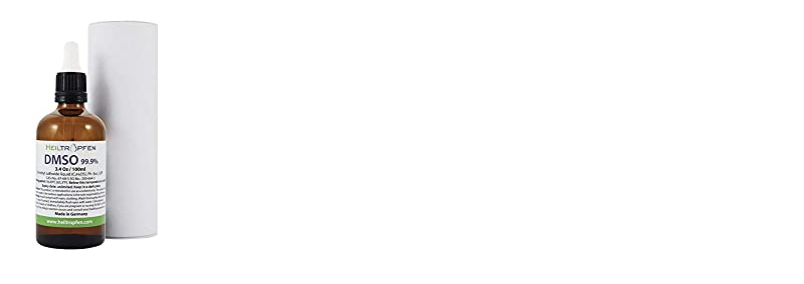
This is something I use clinically for reduction of pain and symptoms. A little dab will do you- rub it into the painful affected areas a few times a day to experience relief of pain.
I’ve researched DMSO extensively and used it myself for guinea pig purposes. I’ve used it with clients. Don’t be scared of it- it really is perfectly safe and pretty darn effective in the short term.
Well, there you have it. I pray these recommendations are helpful for you and your loved ones. Please feel free to pass the information along to anyone who can use it.
To your health,
Jennifer




